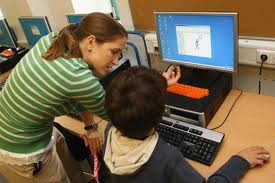02 Dec Telecentres to play a crucial role to create bridges with governments and facilitate adoption of e-Services
02 Dec, 2013
The e-Government paradox
 The high-level e-Government conference titled “Where we are, where we are going” took place in Vilnius, Lithuania on 14th November 2013 in the context of the Lithuanian presidency of the EU and saw Telecentre Europe Director, Chair and two members present their organisations and activities in the session “Inclusive e-Government”. The session was the most focused one on citizen access and adoption of e-Government services.
The high-level e-Government conference titled “Where we are, where we are going” took place in Vilnius, Lithuania on 14th November 2013 in the context of the Lithuanian presidency of the EU and saw Telecentre Europe Director, Chair and two members present their organisations and activities in the session “Inclusive e-Government”. The session was the most focused one on citizen access and adoption of e-Government services. The first speaker, Mr. Gianluca Misuraca from IPTS (a research centre of the European Commission), called the attention of the audience to the “e-government paradox”: although the offer of e-Government services in Europe has reached saturation for most common online services, the users (citizens and to a lesser extent businesses) are still more likely to use traditional methods to interact with the government.
The first speaker, Mr. Gianluca Misuraca from IPTS (a research centre of the European Commission), called the attention of the audience to the “e-government paradox”: although the offer of e-Government services in Europe has reached saturation for most common online services, the users (citizens and to a lesser extent businesses) are still more likely to use traditional methods to interact with the government.
Inclusive e-Government
 Some examples of existing services that were mentioned are:
Some examples of existing services that were mentioned are:– Providing information in easy-to-understand language and with personal guidance with for example short videos on the use of e-Government services
– Specific information services for youth, unemployed and disadvantaged groups such as helping them find work
– Helping SMEs to use e-Government services
The MIREIA survey also highlighted that more than 50% of e-inclusion intermediaries are run by public bodies (libraries, municipal centres) and that therein lies the opportunity to facilitate the e-participation of citizens especially those at risk. Another opportunity for joining efforts between e-inclusion intermediaries and government ca be found in the Local Coalitions for Digital Jobs, which are partnerships between governments, the ICT industry and the civil society and are promoted by telecentre networks across European Countries.









